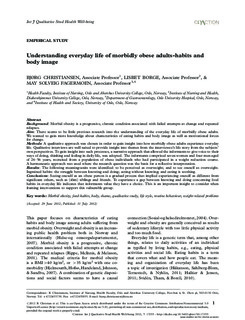| dc.description.abstract | Background: Morbid obesity is a progressive, chronic condition associated with failed attempts at change and repeated relapses.
Aim: There seems to be little previous research into the understanding of the everyday life of morbidly obese adults. We wanted to gain more knowledge about characteristics of eating habits and body image as well as motivational forces for change.
Methods: A qualitative approach was chosen in order to gain insight into how morbidly obese adults experience everyday life. Qualitative interviews are well suited to provide insight into themes from the interviewee’s life story from the subjects’ own perspectives. To gain insight into such processes, a narrative approach that allowed the informants to give voice to their ways of doing, thinking and feeling in daily life, was adopted. The informants comprised seven women and four men aged of 2656 years, recruited from a population of obese individuals who had participated in a weight reduction course. A hermeneutic approach was used where the research question was the basis for a reflective interpretation.
Results: The following meaning-units were identified: to be perceived as overweight; and to see oneself as overweight. Ingrained habits: the struggle between knowing and doing; acting without knowing; and eating is soothing.
Conclusions: Seeing oneself as an obese person is a gradual process that implied experiencing oneself as different from significant others, such as (slim) siblings and friends. To experience a gap between knowing and doing concerning food habits in everyday life indicates that informants value they have a choice. This is an important insight to consider when framing interventions to support this vulnerable group. | no_NO |
